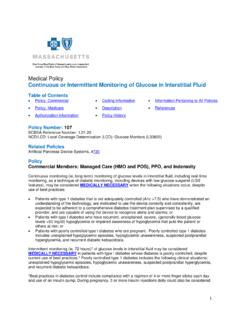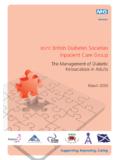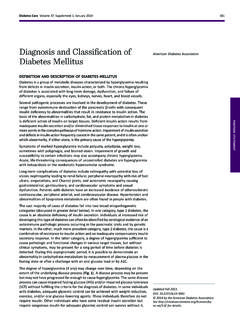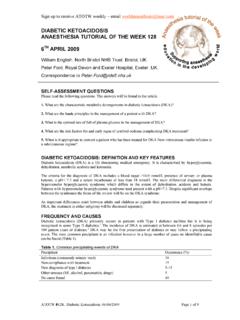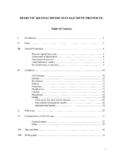Transcription of KIDNEY INFECTIONS IN DIABETES MELLITUS - idb.hr
1 INTRODUCTIONIt is widely held that urinary tract infection (UTI) ismore common in subjects with DIABETES there are relatively few recently publisheddata, there is evidence suggesting that bacteriuria ismore common in females but not in males withdiabetes. Certain renal tract INFECTIONS , includingemphysematous pyelonephritis and cystitis,perinephric abscess, and candidiasis, show closeassociation with DIABETES MELLITUS . These, togetherwith renal papillary necrosis, form the basis of UTI (1).Urinary tract is the most important and most commonsite of infection in diabetic patients. Diabetic patientshave been found to have 5-fold frequency of acutepyelonephritis at autopsy than nondiabetics (2).The incidence of bacteriuria in diabetic men withgood control of blood sugar is reported to be similar asin nondiabetic men, however, in pregnant diabeticwomen it is 2-4 times as common as in control groups(3,4).
2 Most urinary tract INFECTIONS in diabetic patients arerelatively asymptomatic. The presence of diabetespredisposes to much more severe INFECTIONS , especiallyin patients with poor diabetic control, acuteketoacidosis, or diabetic complications such asnephropathy, vasculopathy and neuropathy. Thisasymptomatic infection can lead to severe kidneydamage and cause renal failure (5). In Wheat s review of the issue of INFECTIONS anddiabetes from 1980, 72% of 22 patients withemphysematous pyelonephritis, 80% of 19 patientswith emphysematous cystitis, 57% of 250 patients withpapillary necrosis, 36% of patients with prenephroticabscess, and 10% of 130 patients with metastaticinfection had DIABETES (6).Bacteriuria is very common among diabetic patientsbecause if unrecognizable and inadequately treated, itcan lead to low grade foci of inflammation that canultimately result in serious renal damage (7).
3 Therefore, investigation of bacteriuria in diabeticpatients by screening for urinary tract infection is veryimportant to enable it to be properly treated to preventthe development of renal complications of DIABETES andeventually severe renal damage and failure (8).CLASSIFICATION OF URINARY TRACTINFECTIONS ACCORDING TO TYPE OFINFECTION (9-11)Symptomatic UTIA symptomatic UTI acute recurrent chronic complicated uncomplicated85 Diabetologia Croatica 31-2, 2002112, Parliament Road, Middlesbrough,TS1 4LF United Kingdom2 Vuk Vrhovac Institute, University Clinic for DiabetesEndocrinology and Metabolic Diseases,Dugi dol 4a, HR-10000 Zagreb, CroatiaReviewKIDNEY INFECTIONS IN DIABETES MELLITUSM ahadeva Santhakumar Balachandar1, Pajica Pavkovi 2, @eljko Metelko2 Localization of UTI A. INFECTIONS of upper urinary tract (12,13) acute pyelonephritis chronic pyelonephritisB. INFECTIONS of lower urinary tract (12,13) cystitis urethritisFACTORS INFLUENCING RESISTANCETO URINARY TRACT INFECTION (14-16)1) hyperglycemia2) ketoacidosis3) neutrophil function4) immune response5) influence of endocrine systems6) vascular insufficiency7) neuropathyFACTORS CAUSING COMPLICATIONS INDIABETIC PATIENTS WITH UTI (17,18)Factors predisposing to renal impairments1.
4 Calculus 2. obstruction3. vesico-ureteric reflux4. papillary necrosisFactors predisposing to recurrent infections1. calculus2. scars/spongy medulla3. prostatitis4. foreign bodies in the urinary tract5. urinary tract fistula (vesicoenteral)6. congenital anomaliesFactors predisposing to reinfection1. incomplete voidance of urinary bladderDiabetes can increase proneness to variousinfectionsInfections can cause poor DIABETES regulation(21) increased secretion of counterinsular hormones(glucagon, cortisol, growth hormone and catecho-lamines) insulin secretion inhibition (sympathicus) insulin resistance of peripheral tissues (increasedcytokine secretion) (22)PATHOPHYSIOLOGY OF URINARYTRACT INFECTIONI nfection pathways (23)- ascending- hematogenicInfection factors (23,24)- number of microorganisms- virulence of microorganismsDefense mechanisms of the host (23,24)- length of the urethra- vesicourethral valvula- increased liquid intake and frequent urination- complete voidance of urinary bladderAbnormalities of urinary tract (19,23,24)- obstruction- vesico-ureteric reflux- foreign bodies- incoplete voidance of urinary bladder86M.
5 S. Balachandar, P. Pavkovi , Metelko / KIDNEY INFECTIONS IN DIABETES MELLITUS Renal imaging Normal Abnormal Normal or abnormal with associated disease *Stones No associated * DIABETES MELLITUS *Obstruction disease *Sickle-cell disease/trait *Vesicourethral reflux *Analgesic abuse *NSAID abuse Cause of symptoms No KIDNEY damage
6 Risk of KIDNEY damage and septicemia 'Uncomplicated' 'Complicated' Figure of uncomplicated and com-plicated UTI (9,12,13) Impaired neutrophil function (15-17) Impaired chemotaxis, phagocytosis, adhesion, intercellular destruction of microorganisms Impaired monocyte function Immune disorders (decrease in the levels of complement /C4 / and T-helper lymphocytes) (20) *Vesico-ureteric refluxThe etiology of urinary tract infection includestransfer of organisms from remote foci in the body, fromadjacent sources viabloodstream or lymph channels, orthrough urinary orifices; urinary tract obstruction bystone or other urinary bladder abnormality due toautonomic neuropathy or after catheterization of theurethra; residual urine in the urinary bladder is amedium favoring the growth of organisms (23,24).
7 Acute urinary tract infection is more common indiabetic women due to the short urethra readilyaccessible to organisms from the vagina and rectum(23,24).Bladder has been confirmed to possess an inherentresistance factor, which is necessary for themaintenance of uninfected state. The frequency ofbladder emptying helps reduce the bacterial factor inthe bladder and is thought to be usually develops secondarily to lowerurinary tract infection, as shown in Table 1 (25). Themost common agents of UTI in diabetic patients are: - bacteria- viruses- fungi- tuberculosisBacteriaMany different microorganisms can infect urinarytract in diabetic patients, but the most common agentsof bacteria are gram-negative bacilli; Escherichia colicauses approximately 90% of acute UTI in diabeticpatients without urologic abnormality or calculi. Theother bacilli involved, Protease, Klebsiella,Enterobacter, Serratiaand Pseudomonas, account for alower proportion of uncomplicated INFECTIONS (26,27).
8 These organisms are of increasing importance inrecurrent infection of UTI in diabetic patients,especially after urologic manipulation such as theplacement of catheters for urine retention due toautonomic neuropathy and urinary bladdervasculopathy (25,28,29).The Proteasespecies by virtue of urea production andKlebsiellaspecies through production of extracellularslime and polysaccharides predispose to stoneformation (23,29).Gram-positive cocci play a less important role in UTIin diabetic patients. Enterococci and Staphylococcusaureuscan cause bacteremic infection of the kidneysand consequential renal damage. A saprophyticnovobiocin resistant coagulase negative staphlycoccushas been recognized as an important cause of acutesymptomatic UTI in a young diabetic female (30).Chlamydia trachomatisappears to be an importantetiologic agent (23).Viruses Viruses can cause pyelonephritits in animals and mayincrease the susceptibility of the kidneys to infectionwith coliform bacteria (23).
9 In humans, viruses aremost commonly found in urine samples withoutevidence of acute UTI in diabetic patients, althoughsome adenoviruses have been implicated as a cause ofcystitis (31).FungiFungal infection of UTI in diabetic patients isimportant but clinically insignificant. Diabetic patientswith urinary tract Torulopsis globratainfection accountfor 20%-90% of all INFECTIONS with this Candida globratacan cause cystitis, pyelonephritis,renal or perirenal abscess, fungus ball, and a picture ofgram-negative sepsis (33,34). The presence of candidaat a rate of >10000 colonies/m2urine indicatescandidal infection, but diabetic patients withindwelling catheters may have higher counts with nosignificant evidence of infection by candida, which maylead to chronic infection with severe renal damage(29).TuberculosisTuberculosis is a serious comorbidity in diabetics, inwhom it is more extensive and 3-16 times morecommon than in nondiabetics (24).
10 The association ofUTI and tuberculosis is very common in diabeticpatients due to the impaired body defense87 Diabetologia Croatica 31-2, 2002M. S. Balachandar, P. Pavkovi , Metelko / KIDNEY INFECTIONS IN DIABETES MELLITUSB acterial infectionsFungal infectionsViral infectionsCystitisInvasive candidiasis *Cystitis *Emphysematouscystitis *Renal actinomycosisPyelonephritisPyelonephriti sVulvovaginalcandidiasis *Emphysematouspyelonephritis*Papillary necrosisPerinephritic abscess* close association with DIABETES mellitusTable Not all diabetic patients with microscopichematuria should be automatically regarded asglomerulonephritis as a diabetic complication beforerenal tuberculosis has been excluded (23,35).It may still be advisable to recommend periodictuberculin test in diabetic patients. Those who havenever been tested should receive underdose medicalsupervision, prophylactic treatment with isoniazidpyridoxine for a year due to the greater severity oftuberculosis in diabetic patients (24).




